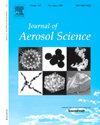Stochastic asymmetric bronchial tree models for population-scale variability in dosimetry
IF 2.9
3区 环境科学与生态学
Q2 ENGINEERING, CHEMICAL
引用次数: 0
Abstract
Pulmonary drug delivery has emerged as a preferred mode of drug administration due to its high effectiveness and reduced side effects compared to other methods. Drugs delivered in this manner can be classified into two classes. Some drugs target the lung tissue and are absorbed in the upper airways. Others aim to reach the deep lung, where they are absorbed into the bloodstream to produce systemic effects elsewhere in the body. The efficacy of drug delivery for both would depend on the regional deposition fraction. Various factors such as particle size, inhalation rate, etc. influence the deposition outcomes. More importantly, the trajectories of inhaled particles depend on the unique geometry of each person’s respiratory tract. Variation in lung anatomy is one of the main reasons why different people respond to inhaled medications differently. In addition, several diseases modify the geometry of the airways, leading to altered particle deposition patterns. Therefore, understanding and predicting regional deposition patterns of inhaled drugs becomes crucial for optimizing drug delivery strategies. To that end, we have developed a stochastic asymmetric multi-path model of the human airways. The tracheobronchial airways were generated based on Hess-Murray’s law and stochastic asymmetric branching. Symmetric and alveolated acinar sub-trees were attached to the terminal bronchioles. Through Monte-Carlo simulations, we report the extent, distribution and inter-subject variability in inhaled particle deposition as a function of several key parameters - branching asymmetry, particle size, breathing rate and bronchoconstriction. We show how particle size influences the deposition of particles, how asymmetry generally reduces deposition (barring certain exceptions) and how bronchoconstriction reduces deposition in the deep lung while increasing it in the upper airways. These insights will prove useful in determining drug dosages as well as design and choice of delivery devices such as inhalers and nebulizers.
剂量学中种群尺度变异性的随机不对称支气管树模型
与其他方法相比,肺给药因其高效且副作用小而成为首选的给药方式。以这种方式递送的药物可分为两类。有些药物以肺组织为靶点,在上呼吸道被吸收。另一些则旨在到达肺部深处,在那里它们被血液吸收,在身体其他部位产生全身效应。两种药物的递送效果取决于区域沉积分数。颗粒大小、吸入速率等因素影响沉积效果。更重要的是,吸入颗粒的轨迹取决于每个人呼吸道的独特几何形状。肺解剖结构的差异是不同人对吸入药物反应不同的主要原因之一。此外,一些疾病改变气道的几何形状,导致颗粒沉积模式改变。因此,了解和预测吸入药物的区域沉积模式对于优化药物递送策略至关重要。为此,我们开发了一个人类气道的随机非对称多路径模型。气管支气管是基于Hess-Murray定律和随机不对称分支生成的。末端细支气管上附着对称的泡状腺泡亚树。通过蒙特卡罗模拟,我们报告了吸入颗粒沉积的程度、分布和主体间变异性作为几个关键参数的函数-分支不对称、颗粒大小、呼吸频率和支气管收缩。我们展示了颗粒大小如何影响颗粒的沉积,不对称如何通常减少沉积(排除某些例外)以及支气管收缩如何减少深肺沉积而增加上呼吸道沉积。这些见解将有助于确定药物剂量,以及设计和选择吸入器和雾化器等输送装置。
本文章由计算机程序翻译,如有差异,请以英文原文为准。
求助全文
约1分钟内获得全文
求助全文
来源期刊

Journal of Aerosol Science
环境科学-工程:化工
CiteScore
8.80
自引率
8.90%
发文量
127
审稿时长
35 days
期刊介绍:
Founded in 1970, the Journal of Aerosol Science considers itself the prime vehicle for the publication of original work as well as reviews related to fundamental and applied aerosol research, as well as aerosol instrumentation. Its content is directed at scientists working in engineering disciplines, as well as physics, chemistry, and environmental sciences.
The editors welcome submissions of papers describing recent experimental, numerical, and theoretical research related to the following topics:
1. Fundamental Aerosol Science.
2. Applied Aerosol Science.
3. Instrumentation & Measurement Methods.
 求助内容:
求助内容: 应助结果提醒方式:
应助结果提醒方式:


